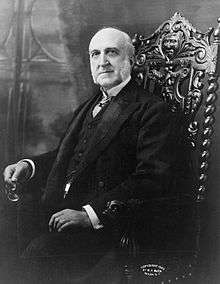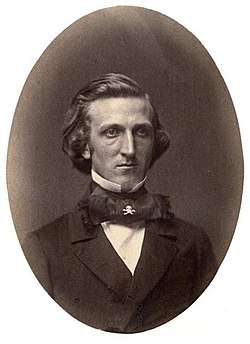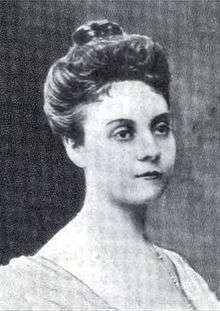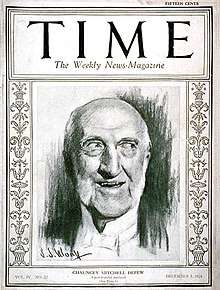Chauncey Depew
Chauncey Mitchell Depew (April 23, 1834 – April 5, 1928) was an attorney for Cornelius Vanderbilt's railroad interests, president of the New York Central Railroad System, and a United States Senator from New York from 1899 to 1911.[1]
Chauncey Depew | |
|---|---|
 | |
| United States senator from New York | |
| In office March 4, 1899 – March 3, 1911 | |
| Preceded by | Edward Murphy, Jr. |
| Succeeded by | James A. O'Gorman |
| Secretary of State of New York | |
| In office January 1, 1864 – December 31, 1865 | |
| Governor | Horatio Seymour Reuben Fenton |
| Preceded by | Horatio Ballard |
| Succeeded by | Francis C. Barlow |
| Member of the New York State Assembly from the Westchester County, 3rd District district | |
| In office January 1, 1862 – December 31, 1863 | |
| Preceded by | Benjamin F. Camp |
| Succeeded by | George A. Brandreth |
| Personal details | |
| Born | Chauncey Mitchell Depew April 23, 1834 Peekskill, New York, US |
| Died | April 5, 1928 (aged 93) New York City, US |
| Political party | Republican |
| Spouse(s) | Elise A. Hegeman
( m. 1871; w. 1893)May E. Palmer
( m. 1901; d. 1928) |
| Parents | Isaac Depew Martha Minot Mitchell |
| Education | Peekskill Military Academy |
| Alma mater | Yale College |
| Profession | Politician |
Early life
Depew was born on April 23, 1834 to Isaac Depew (1800–1869) and Martha Minot (Mitchell) Depew (1810–1885). His father was a merchant and farmer; pioneer in river transportation between Peekskill and New York; son of Abraham Depew, who served in the Revolutionary Army, and Catherine (Crankheit) Depew, great-grandson of Captain James Cronkite of the Continental Army; descendant of François DuPuy, a French Huguenot, who came to America about 1661, settled first in Brooklyn, N. Y., and in 1685 bought land from the Indians at the present site of Peekskill. His mother was the daughter of Chauncey Root Mitchell, a lawyer, and Ann (Johnstone) Mitchell; granddaughter of the Rev. Justus Mitchell (BA 1776); great-granddaughter of the Rev. Josiah Sherman (B A. Princeton 1754, honorary M.A. Yale 1765), who served as a chaplain with rank of captain in the Revolutionary War and who was the brother of American founding father Roger Sherman; descendant of Matthew Mitchell, who came to Boston from England in 1635, descended also from Capt. John Sherman, an English officer, who was born in Dedham, Essex County, in 1615, and from the Rev. Charles Chauncey (B.A. Trinity College, Cambridge, 1613), who came to Plymouth in 1637 and was the second president of Harvard.
Education
He attended Peekskill Military Academy for 12 years. During his college years at Yale (from 1852 to 1856), Depew joined many clubs and won several honors: second dispute appointments Junior and Senior years; speaker at Junior Exhibition and Commencement; member of the Thulia Boat Club, Linonia (third president), Kappa Sigma Epsilon, Kappa Sigma Theta, Psi Upsilon, and Skull and Bones.[2]:165 At Yale, he was a classmate of future US Supreme Court Justices David Josiah Brewer and Henry Billings Brown.

Career
Legal career
After graduating from Yale, Depew entered the office of Edward Wells, a lawyer in Peekskill, as a student. Depew then read law with William Nelson of Peekskill, New York from 1856–58. He was admitted to the bar in March 1858; opened an office and practiced in Peekskill until 1861. For a few months, Depew engaged in the brokerage business in New York City as a member of the firm Depew & Potter, but then resumed his law practice in Peekskill. Depew later moved to New York City. During the American Civil War, Depew served as Adjutant of the 18th Regiment, New York National Guard,[3] and later Colonel and Judge Advocate of the 5th Division, on the staff of Major General James W. Husted of the New York Guard.[4]
In 1865 Depew was appointed and confirmed United States Minister to Japan, but declined the appointment to pursue his career as a railroad and business lawyer.[5]
Railroad lawyer
In 1866, Depew became the attorney for New York & Harlem Railroad. Three years later he took the same position for the New York Central and Hudson River Railroad. Having earned recognition for his work with subsidiary companies of the Vanderbilt roads, in 1876 Depew became general counsel and director of the whole "Vanderbilt System." Six years later he began serving on the executive board of the New York Central & Hudson River Railroad and also became its second vice president. In 1885, Depew was elected that railroad's president and served in that capacity until 1898 when he was succeeded by Samuel R. Callaway.[6][7] Depew then became chairman of board of directors of New York Central Railroad Company.
While Depew was active in the Vanderbilt railroads in and through New York, he held concurrent positions with many other railroads and companies. He was president of West Shore Railroad. He served on the boards of directors for the New York and Harlem Railroad, the Chicago and North Western Railway, the Chicago, St. Paul, Minneapolis and Omaha Railway, the Cleveland, Cincinnati, Chicago and St. Louis Railroad, the Delaware and Hudson Railroad, the New Jersey Junction Railroad, the St. Lawrence and Adirondack Railroad, the Wallkill Valley Railroad, the Canada Southern Railroad.
Aside from railroads, Depew also served on the boards of directors for Western Union, the Hudson River Bridge Company, the Niagara River Bridge Company, the New York State Realty & Terminal Company, the Union Trust Company, Equitable Life Assurance Company, and Kensico Cemetery Association.
Politics

Depew served in the New York State Assembly (Westchester County, 3rd District) in 1862 and 1863. During the latter year, he sometimes acted as Speaker pro tempore while Speaker Theophilus C. Callicot was under investigation.[8] From 1864 to 1865, he was Secretary of State of New York, elected in 1863 on the Union ticket.
In 1867, Depew became clerk of Westchester County but resigned after a short service. In 1870 the New York Legislature named Depew Immigration Commissioner, but he declined to serve. Depew had also been commissioner of quarantine and president of Court of Claims of New York City as well as commissioner of taxes and assessments for the city and county of New York. Depew was one of the commissioners appointed to build the state capitol 1874; and a member of the state's boundary commission in 1875.
Depew was defeated for Lieutenant Governor of New York on the Liberal Republican-Democratic ticket in 1872. Nine years later, Depew became a candidate for U.S. Senator in an 1881 special election, but withdrew after the 41st ballot. He also declined nomination as a senator in 1885; but was elected to the U.S. Senate in 1899, and re-elected in 1905, and served from March 4, 1899, to March 3, 1911.
The late Senator Robert Kerr of Oklahoma once quoted Chauncey Depew in an attack on a Senator from Indiana, "As I gaze on the ample figure of my friend from Indiana, and as I listen to him," Kerr began, "I am reminded of Chauncey Depew who said to the equally obese William Howard Taft at a dinner before the latter became President, 'I hope, if it is a girl, Mr. Taft will name it for his charming wife.' "To which Taft responded, 'if it is a girl, I shall, of course, name it for my lovely helpmate of many years. And if it is a boy, I shall claim the father's prerogative and name it Junior. But if, as I suspect, it is only a bag of wind, I shall name it Chauncey Depew.'"[9]
Depew stumped the state of New York for John C. Frémont in 1856 and for Abraham Lincoln in 1860. He served as a delegate-at-large to Republican National Conventions 1888-1904 and delegate to all following conventions, including 1928, being elected the day before he died. He made the nomination speeches for Harrison in 1892, Governor Morton in 1896, and Fairbanks in 1904. At the convention in 1888, Depew received 99 votes for the presidential nomination, and in 1892 declined an appointment as Secretary of State in Harrison's cabinet.
On October 7, 1897, Depew inaugurated the New York pneumatic tube mail, declaring: "This is the age of speed. Everything that makes for speed contributes to happiness and is a distinct gain to civilization. We are ahead of the old countries in almost every respect, but we have been behind in methods of communication within our cities. In New York this condition of communication has hitherto been barbarous. If the Greater New York is to be a success, quick communication is absolutely necessary. I hope this system we have seen tried here to-day will soon be extended over all the Greater New York."[10]
In 1898, Depew nominated Theodore Roosevelt for Governor of New York at the Republican state convention.
In 1906, David Graham Phillips began a muckraking series entitled "The Treason of the Senate" for William Randolph Hearst's new Cosmopolitan magazine, and targeted Depew in the first article. The article's sensational charges included labeling Depew a "boodler" owned "mentally and morally" by railroad magnates Cornelius and William Vanderbilt. The piece provoked outrage from groups as diverse as President Roosevelt, the New York Sun and Senator Henry Cabot Lodge.[11]
Personal life

Depew married twice. On November 9, 1871, he married Elise Ann Hegeman (1848–1893) in New York City. She was the daughter of William and Eliza Jane (Nevin) Hegeman. Before her death on May 7, 1893, they had one son, Chauncey Mitchell Depew, Jr. (1879–1931),[12] who died unmarried.[13]
On December 27, 1901, he married May Eugenie Palmer (1866–1940) in Nice, France. She was the daughter of Henry and Alice (Hermann) Palmer. In 1929, May Palmer-Depew donated the papers of her late husband to George Washington University, as well as $120,000 to establish a department of public speaking in her husband's memory.[14] The collection is currently cared for by the university's Special Collections Research Center, located in the Estelle and Melvin Gelman Library.[15]
Depew was the paternal uncle of Ganson and Chauncey Depew, sons of his brother William Beverly Depew. Ganson Depew became a vice president of the Buffalo & Susquehanna Coal Company; after marrying Grace Goodyear he became the personal assistant of his father-in-law Frank Henry "F.H." Goodyear (who was the president of the Buffalo and Susquehanna Railroad). They had two children, Ganson and Lucia Depew. His nephew Chauncey DePew worked for the Vanderbilt Railway Systems like his uncle, and married Julia Catlin Park, but later divorced.
In spring 1928, as he was returning from Florida to Manhattan, he became ill and died of bronchial pneumonia, a week later, on April 5, 1928 in Manhattan.[1] He was buried in the family mausoleum in Hillside Cemetery, Peekskill. In his honor, the huge concourse of Grand Central Terminal was draped in mourning.
Yale
He was a member of Yale Corporation 1888–1906; member of the Yale Alumni Association of New York at the time of its organization in 1868, served as its third president from 1883–1892, and was one of the incorporators of the Yale Club of New York City in 1897. He was a vice chairman of the $20,000,000 Yale Endowment Campaign, made LL D. Yale 1887, and was elected an honorary member of Yale Class of 1889 in 1923. In his will and upon his death, he left $1,000,000 to Yale without restrictions as to its use.
Associations and civic activities
In 1877, Depew became a regent of the University of the State of New York, and served on that board until 1904. He also served as trustee of Peekskill Military Academy. In 1887, Depew became an honorary member of Columbia chapter of Phi Beta Kappa. In 1918, Depew was made life member of Lawyers' Club of New York.
Depew was active in a number of patriotic and hereditary societies. He served as president of Empire State Society of the Sons of the American Revolution from 1890 to 1899, the Pilgrims Society from 1918 until his death, the Saint Nicholas Society, and the Union League for seven years. He was a member of the Union League since 1868 and was elected an honorary life member at the close of his presidency. He was also a member of the Connecticut Society of the Cincinnati, the New York Society of Colonial Wars, Holland Society, Huguenot Society and the New England Society of New York.
Depew became an honorary member New York Genealogical and Biographical Society, and his other cultural memberships included: the Metropolitan Museum of Art, American Association for the Advancement of Science, France-America Society, New York Historical Society, Historical Society of St. Augustine, Fl., American Scenic and Historic Preservation Society, National Horse Show, Lafayette Post of the Grand Army of the Republic, Saint Thomas Episcopal Church in New York, and the citizens' committee to complete the Cathedral of St. John the Divine, also in New York City.
Depew received the French Légion d'honneur in the rank of Officer. He was vice president of New York Chamber of Commerce from 1904 to 1908, having been a member since 1885.
In 1886, Depew gave an oration at the unveiling of the Statue of Liberty.[16]
Depew was also a distinguished orator and after-dinner speaker, and published many of those speeches: Orations and After Dinner Speeches (1890), Life and Later Speeches (1894), Orations, Addresses and Speeches (eight volumes) (1910), Speeches and Addresses on the threshold of Eighty (1912), Addresses and Literary Contributions on the Threshold of Eighty-two (1916), Speeches and Literary Contributions on the Threshold of Eighty-four (1918), My Memories of Eighty Years and Marching On a/k/a My Autobiography (1922); Miscellaneous Speeches on the Threshold of Ninety-two (1925); and an article to the 50th Anniversary Supplement of the Yale Daily News entitled "An Optimistic Survey" in 1928.
Legacy

In 1908, Depew gave land to Peekskill, New York which became Depew Park, and a decade later expanded the donation by 10 acres (40,000 m2) acres, and also paid for a statue of himself for display in that park.
The Village of Depew, New York,[17] incorporated in 1894 located along the New York Central Railroad main line just outside of Buffalo, New York, was named after him. The town of Depew, Oklahoma is also named for him.[18]
Many artists painted Depew, including George Burroughs Torrey. The Swiss-born American artist Adolfo Müller-Ury painted Depew numerous times, including in 1889-90. The three-quarter length portrait of Depew seated on a bale of furs which was exhibited at the Paris Salon in 1890, is now in the Yale Club of New York City. Several other portraits followed including a portrait painted for the New York State Capitol at Albany showing Depew as he was in 1863 (now New York State Museum). The artist gave a bust-length portrait to the Museum at Peekskill in 1918. Muller-Ury made an etching of Depew (copies, signed by the artist and the sitter, are in the American National Portrait Gallery in Washington DC and in the collection of the Newport Preservation Society Rhode Island, and University of Cincinnati College of Design). Muller-Ury also painted Depew's first wife in 1893, and his second wife in 1902 in 18th-century costume.
The Chauncey M. DePew was a ship named in his honor. The vessel was built for the Maine Central Railroad Company in 1913 to carry passengers to Bar Harbor. She worked along the Maine coast until 1925 when she was sold to the Day Line as an excursion boat between New York and Albany. In 1940 she was drafted to carry men and supplies between New York City and Fort Hancock on Sandy Hook. In 1950, she was sold to the government of Bermuda and spent the next 20 years as a ship's tender, harbor ferry, cruise ship and pilot boat. Back in the States, in 1971, a storm slammed her against a breakwater in Chesapeake Bay, where she lay for three years. She was refurbished and moored in the Hackensack River between Harmon Cove and the Hackensack River Route 3 Bridge, [19][20][21] [22] Another boat, a tugboat that was part of New York Central, was also named for him.[23]
References
Notes
- "Chauncey M. Depew Dies Of Pneumonia In His 94th Year. Family at Bedside of the Ex Senator When End Comes in Early Morning. Was Ill Only A Week. Stricken With a Chill on His Way North on the Train From Florida. Continued Duties as Chairman of New York Central Board to the Last". The New York Times. April 5, 1928. Retrieved 2015-01-13.
Chauncey M. Depew died at his home, 27 West Fifty-fourth Street, at 4:20 o'clock this morning. He would have been 94 years old on April 23. ...
- Robbins, Alexandra (2002). Secrets of the Tomb: Skull and Bones, the Ivy League, and the Hidden Paths of Power. Boston: Little, Brown. ISBN 0-316-72091-7.
- Leonard, John William (1911). Who's Who in Finance, Banking, and Insurance, Volume 1. Joseph & Sefton. p. 557.
- New York Adjutant General (1909). Annual Report, Volume II. J. B. Lyon Company. p. 98.
- Murlin, Edgar L. (1909). The New York Red Book. J. B. Lyon Company. p. 34.
- "The New York Central's New President". The Railway Agent and Station Agent. National Association of Railway Agents. XIX (2): 15–17. April 1898.
- "Samuel R. Callaway". Railroad Men. XVII (10): 365 and 387. July 1904.
- Depew: My Memoirs of 80 Years (Depew reminisces not quite correctly; see Journal of the Assembly (86th Session))
- "Scribe Suggests Insult Proposal". The Daily Herald, Provo, Utah. 9 April 1974.
- "Mail Tube is a Success". The New York Times. 8 October 1897.
- D. K. Goodwin, The Bully Pulpit (Simon & Schuster, 2013) pp. 480–482
- "C.M. DEPEW JR.'S FUNERAL. | Services Held In Chantry of St. Thomas—Burial at Peekskill". The New York Times. January 29, 1931. Retrieved 6 October 2016.
- "CHAUNCEY M. DEPEW ILL. | Son of the Late Senator Is Stricken With Pneumonia". The New York Times. January 26, 1931. Retrieved 6 October 2016.
- King, Jennifer. "GUIDE TO THE CHAUNCEY M. DEPEW PAPERS, 1856–1934". gwu.edu. George Washington University. Retrieved 6 October 2016.
- Guide to the Chauncey M. Depew Papers, 1856–1934, Special Collections Research Center, Estelle and Melvin Gelman Library, The George Washington University
- Depew, Chauncey M. Orations, addresses and speeches of Chauncey M. Depew, pp. 96-108.Private printing, 1910. Online facsimile of volume held by Columbia University Libraries. Full digital text at Internet Archive. Largely celebrating American democracy and the friendship between France and the USA, Depew, likely referring to the recent Haymarket affair, also remarked, "The rays from this beacon, lighting this gateway to the continent, will welcome the poor and the persecuted with the hope and promise of homes and citizenship. It will teach them that there is room and brotherhood for all who will support our institutions and aid in our development; but that those who come to disturb our peace and dethrone our laws are aliens and enemies forever."
- Gannett, Henry (1905). The Origin of Certain Place Names in the United States. Govt. Print. Off. p. 104.
- Wilson, Linda D. Encyclopedia of Oklahoma History and Culture. "Depew." Retrieved March 23, 2012. Archived 2008-12-30 at the Wayback Machine
- "CHAUNCEY M. DEPEW - ShipSpotting.com - Ship Photos and Ship Tracker". www.shipspotting.com. Retrieved 25 February 2019.
- Prial, Frank J. (28 August 1977). "Dining Out". Retrieved 25 February 2019 – via NYTimes.com.
- "The Chauncey M Depew in Bermuda - Ships Nostalgia Gallery". www.shipsnostalgia.com. Retrieved 25 February 2019.
- "The New Yorker Digital Edition : Aug 31, 1935". archives.newyorker.com. Retrieved 25 February 2019.
- Adams, Arthur G. (25 February 1996). The Hudson Through the Years. Fordham Univ Press. Retrieved 25 February 2019 – via Internet Archive.
west shore railroad ridgefield park.
Sources
External links
| Wikimedia Commons has media related to Chauncey Depew. |
| Wikiquote has quotations related to: Chauncey Depew |
| Wikisource has the text of the 1911 Encyclopædia Britannica article Depew, Chauncey Mitchell. |
- United States Congress. "Chauncey Depew (id: D000264)". Biographical Directory of the United States Congress.
- Guide to the Chauncey M. Depew Papers, 1856–1934, Special Collections Research Center, Estelle and Melvin Gelman Library, George Washington University
- Chauncey Depew at Find a Grave
- Works by Chauncey Depew at Project Gutenberg
- Works by or about Chauncey Depew at Internet Archive
- Mr. Lincoln and New York: Chauncey M. Depew
- The 1899 Empire State Society Register
- Vanderbilt Railroads President Scripophily.net
- Image of Chauncey Depew from "1888 Presidential Possibilities" card set t207.com
- Chauncey DePew (1925) early sound film made in DeForest Phonofilm sound-on-film process at SilentEra
- Sherman Genealogy Including Families of Essex, Suffolk and Norfolk, England By Thomas Townsend Sherman
| New York State Assembly | ||
|---|---|---|
| Preceded by Benjamin F. Camp |
New York State Assembly Westchester County, 3rd District 1862–1863 |
Succeeded by George A. Brandreth |
| Political offices | ||
| Preceded by Horatio Ballard |
New York Secretary of State 1864–1865 |
Succeeded by Francis C. Barlow |
| U.S. Senate | ||
| Preceded by Edward Murphy, Jr. |
U.S. senator (Class 1) from New York 1899–1911 Served alongside: Thomas C. Platt and Elihu Root |
Succeeded by James A. O'Gorman |
| Honorary titles | ||
| Preceded by Cornelius Cole |
Oldest living U.S. Senator November 3, 1924 – April 5, 1928 |
Succeeded by Rebecca Felton |
| Awards and achievements | ||
| Preceded by William R. Inge |
Cover of Time Magazine 1 December 1924 |
Succeeded by Plutarco Calles |
